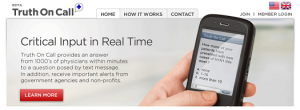
Begun as a music conference, SXSW gave birth to its Interactive component in 1994. At the time, it was basically a room full of nerds talking about CD-Roms. This year, registration for the Interactive programming actually surpassed that for music. This year's gathering brought together hundreds of thinkers and doers in the digital space, all working together to lay out the industry's future, and mobile was a part of nearly every discussion. This is a far cry from its humble beginnings, back when digital meant desktop and cell phones looked like this.
Over 35 panels and presentations were about mobile specifically. Barcodes were scattered across Austin, the location wars raged, and Twitter continued its dominance as a primary form of communication.
The trend is clear: Digital is breaking free. The tethered desktop is old thinking; interactivity is everywhere now. With less and less friction, mobile devices are becoming extensions of our selves. They create a mobile networked society, able to interact with objects and data in the world around us.
In this series, we will explore our observations around SXSW Interactive 2010. First up: the feedback loop.

Designers are drafting mobile systems that give organizations the ability to learn about users, and then return the favor with valuable feedback. Through this feedback loop, brands are presented with a powerful opportunity to engage consumers in their everyday lives, made possible by the ubiquitous mobile phone.
"As mobile phones become more context aware, the trigger-behavior coupling will go beyond the desktop into our active lives. The mobile phone will be a channel for triggering many behaviors." - BJ Fogg
During the talk Designing for Awareness, Robert Fabricant of Frog Design describes Augmented Mindfulness. It takes personal analytics to the next level by "recording behavior, processing the data collected, and feeding it back to the individual or group so that they can better understand the patterns of their activity.” Through this, we are better able to solve problems that we were originally unaware of.
On the individual level, the mobile-enabled feedback loop has a lot of potential in areas like finance and healthcare. Mint collects a large amount of valuable data on consumer spending habits but also visualizes it for users. Imagine if Kroger or Duane Reade could present shoppers with a graph of their personal spending patterns based on data collected through a loyalty card. In terms of healthcare, Track Your Happiness, Sleep Cycle, Lose It!, and 100 Pushups are all personal analytic applications that can change behavior through the information collected by our mobile device.

Location-based networks like Foursquare collect an enormous amount of data. While the current incentives are things like social interactions and badges, the company could feed back much more about a user and further encourage application use. Place history is one thing that could come into play. During a flash panel at Pepsi's Podcast Playground, Dennis Crowley hinted at something similar to intuitive search. What if the next time you came to Austin, Foursquare remembered where you had been and reminded you or even suggested new venues? The Jetsetter badge, for example, lets users know that they've been to five airports. This is just the beginning, as a lot more can be done with properly architected data.
It doesn't stop at the individual level. Crowdsourcing efforts that benefit from both active and passive contributions by mobile users can be even more successful when users are shown the results. When individuals understand their contribution to the whole, sharing gets positive reinforcement.

During The City Is A Platform, panelists discussed the user-generated data being provided via mobile phones. With SeeClickFix, users report on potholes and long traffic lights in order to get local governments to improve their cities. Naturally, people do this with the hope that their contribution will yield results. Assaf Biderman from MIT SENSEable City Lab described people as the actuators in a city, reacting on the information that sensors will collect. When sensors are human enabled, as through active mobile crowdsourcing, then reporting keeps the machine running. Creations like NoiseTube, Project Noah, and Pachube consider humans as sensors, and a well constructed feedback loop where contributers can see the value of their organized effort will help them succeed.












